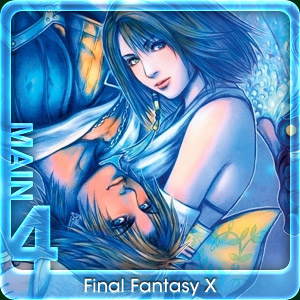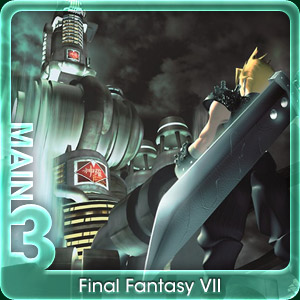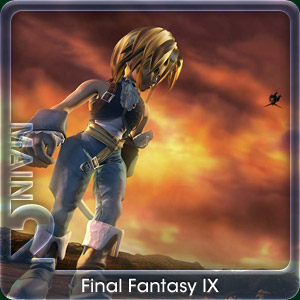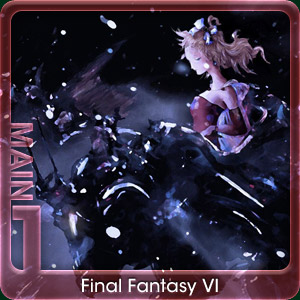

When Final Fantasy IV (Final Fantasy II in the West) was released in the US, it was certainly a departure from every other Final Fantasy game offered to US audiences. Instead of taking a pen-and-paper RPG approach of nameless, faceless characters, FFIV offered defined, carefully-crafted protagonists and NPCs. The five-person party changed as the game went on, yet all the characters proved memorable in their designs, their actions in the story, and their innate abilities. As the story of FFIV went on, the stakes kept rising. The tension kept building. Plots were twisted. The enemies were carefully designed, with some of the most interesting and detailed art in any SNES game of the time. And, the degree of difficulty was enough to give a challenge to even the most seasoned RPG gamer.
More than any other Final Fantasy game before or since, FFIV offered a true theme that carried throughout the entire game: redemption. Cecil's character arc defined him as a man trying to make amends for his dark past. Other characters in the game found themselves coming to grips with the consequences of their actions and the darkness in every person's soul. By today's standards, some might see the story as simplistic and the characters one-dimensional, but all the characters had idiosyncrasies and deliberate designs, even if not all of them received the screen time they deserved.
Final Fantasy IV was filled with memorable moments and engaging gameplay. With its focus on character, unique art, and a blend of technology and magic, in many ways it was the template for every Final Fantasy game to come. And alone, it still stands the test of time today as a game that is re-released more often than any other FF title.
 Listen to my story. This may be our last chance.
Listen to my story. This may be our last chance. With those famous words, a journey more intense than we'd ever imagined began. Final Fantasy X did for modern RPGs what Final Fantasy VII did for PSone era titles: it changed the standard to which we held our beloved JRPGs. Beyond what Final Fantasy VII did with its burgeoning cinematics, Final Fantasy X was the first game to be a true convergence of theatrical-style cinematics and gameplay. Along with these cinematics, all the lines in the game were fully voice acted - something that's now become an absolute must in modern RPGs. Add a romance between two lost souls and you had something special: an awkward laughing scene, a longing to hear them exchange the words "I love you," and that intimate lake scene that fans will never forget. The heartfelt romance aside, the greatest success of Final Fantasy X was having characters who you couldn't help but feel deeply attached to. There are many intense feelings explored in this game, but it also had some lighthearted moments thanks to Wakka and Rikku. Who wouldn't want to be friends with them?
More importantly, how can you think of Final Fantasy X and not think of blitzball and the sphere grid? The latter added a dynamic element to character development by giving the player almost complete control over the skill progression of every character. Blitzball, while not the most competent mini-game in an RPG, provided a consistent backdrop to the story and a competitive spirit to its contenders. And in all of this, Final Fantasy X succeeded in resurrecting a true turn-based battle system that played out just as quickly as an ATB battle. Alongside this new battle system stayed old standbys, though; Limit Breaks became Overdrives and there were still plenty of characters with crazy hair. And who could forget those sidequests that people are
still talking about? Did you dodge all 200 lightning bolts? Were you able to get less than zero seconds in the Chocobo race? Those challenges took a passionate fan to put in the effort to take down. All-in-all, Final Fantasy X was a profound title in a two-fold way: the game paved the way for the modern JRPG and provided a story that's still beloved today.

I really can't add much to the great Final Fantasy VII debate. The 1997 PSOne title has been argued, analyzed, and basically ripped apart by fanboys, haters, and even the very company that gave it life. Wherever you stand on the FFVII spectrum, you have to admit that the game changed everything when it came to RPGs. Simply put, we had never seen anything so epically grandiose in design and pure spectacle in our entertainment medium. FFVII helped define an entire console generation, and that's something that no one can argue about. The merits of Cloud and company's contribution to gaming will be under scrutiny for the next decade as Square Enix continues to retcon the living hell out of the series. I can't wait to see the eventual sequel that puts Barret's daughter up against yet another Sephiroth clone.
But set aside all the ancillary crap attached to FFVII and you have a game that is utterly insane, but still charming in many ways. The plot remains ambitious and thought-provoking, even if the last act can't sustain itself. The colorful characters and dialog helped to differentiate this game from nearly every other RPG out there, though there are disposable stereotypes that take away from the more important players in this grand adventure. And the battle system, while seemingly bland, allows for a great deal of player control and customization. FFVII is in no way perfect, but I find it's the only game in the franchise that I've been able to play through multiple times. Most of this has to do with the brilliant pacing of the first disc, where the linear take on the genre is in full effect to heighten the severity of the situation. AVALANCHE must stop Shin-Ra from destroying the planet, and they have to do so quickly and efficiently. The action is fast-paced and sustained, and the eventual escape from Midgar provides the freedom so desperately sought by the denizens of the corporate city. After that, well, FFVII becomes quite the little mess of awkward set-piece moments and oddly placed mini-games (post-funeral snowboarding, anyone?). The story and characters spiral out of control, and eventually you're fighting an angel while a Latin choir sings incessantly in the background.
Final Fantasy VII is similar to another epic from Japan released around the same time: Evangelion. Both turned into monster franchises that helped bring Japanese culture over to America. Sure, Evangelion and FFVII have numerous problems (incoherent plots, ambiguous endings, rabid fanboy praise, and a complete lack of direction at times), but the insanity associated with both sagas helps to bring the good stuff to the foreground. Both franchises took huge risks that you just don't see today. FFVII managed to captivate a generation of gamers because we had never seen anything like it before, and that's why it holds a special place in our hearts over a decade later. It may not be my favorite RPG, but FFVII is probably the most memorable one I've ever played.

The last title in the trilogy of PlayStation Final Fantasies broke away from the high-tech modernity of its two predecessors and offered a more medieval, steampunk setting that harkened back to earlier entries in the series. Final Fantasy IX is rightly viewed by many as a love letter to the series from itself, as nearly every aspect of its design was engineered to honor the games that came before. Chocobos, black mages, moogles, and airships were just the surface aspects of a game that attempted to combine the best of the old with the best of the new.
The game had a simple yet addictive system for learning abilities: each piece of equipment had a set of abilities to learn by equipping it. This created a great impetus for hunting down every last sword or piece of armor in the game and made the entire endeavor very rewarding. Combat was the then-series-standard Active Time Battle turn-based system, though the maximum party size was bumped from three to four for the first time since Final Fantasy VI. The music was vintage Nobuo Uematsu (and in fact, his favorite soundtrack that he wrote for the series), and the graphics combined the cartoony, super-deformed style that was made popular in the classics with the detailed 3D and pre-rendered backgrounds of the other PS1 titles. But, more important than any of those things, is the game's cast. Full of colorful, memorable, well-developed characters, the cast is one of the strongest the series has yet seen. The protagonist, Zidane, remains to this day one of the most mold-breaking, likeable heroes in the series – not to mention that he almost totally sidestepped the heavy amount of brooding endemic to his predecessors, instead coming off as a goofy, Robin Hood-style charmer with an eye for justice – and the ladies.
The game's Active Time Event system took the skits of the Tales series and turned them into full-blown character-development cutscenes, and for the first time in the series, humor made its way into the game. That humor helped to offset the drama and made players feel more invested in the characters, something that later entries (like Final Fantasy XIII) could have really used. The focus on the strong cast made the game's story easy to care about, and, when combined with the game's numerous other good qualities, makes this Fantasy one of the best in the series. How did we feel after playing? As Quina once said, "I so happy."

The last 2D title in the main series, Final Fantasy VI graced many a Super Nintendo under the title Final Fantasy III in the West. Its 1994 release came during the pinnacle of the 16-bit RPG era. Even though Final Fantasy VII took the series to a whole new level both graphically and in popularity, VI held its own over time and remains one of the most beloved of the series even today. Not only did its story leave a lasting impression, but the 2D graphics were some of the most impressive from the SNES era. In particular, the opera scene stands out for both a detailed background and animated orchestral pit.
Story-wise, the first half carefully crafted its perfectly-sized cast of characters, their backstories and their friendships. In the second, the World of Ruin, this palette of personalities was shattered into a number of fragments. Yet the bonds formed earlier saw these friends find their way back to each other for one final showdown with Kefka - the same villain who did what few could actually claim: he managed to destroy the world. Kefka was memorable for being both amusing yet still capable of genocide (poisoning the water of Doma, Cyan's hometown) – as well as an epic final boss. Dancing Mad, that battle's 20-minute theme, remains a highlight of what is already one of Nobuo Uematsu's best soundtracks to date.
To that (and every other) battle, each character brought his or her unique set of abilities, yet this was one of the last last Final Fantasy games where this really was the case. With a game this memorable, and well-done in just about every category, it is no wonder that Final Fantasy VI is considered the top pick in 'The Best Final Fantasy Games.'
#6: Final Fantasy VIII
#7: Final Fantasy XII
#8: Final Fantasy XIII
#9: (tie) Final Fantasy V & Final Fantasy XI
Back to Feature Intro

 When Final Fantasy IV (Final Fantasy II in the West) was released in the US, it was certainly a departure from every other Final Fantasy game offered to US audiences. Instead of taking a pen-and-paper RPG approach of nameless, faceless characters, FFIV offered defined, carefully-crafted protagonists and NPCs. The five-person party changed as the game went on, yet all the characters proved memorable in their designs, their actions in the story, and their innate abilities. As the story of FFIV went on, the stakes kept rising. The tension kept building. Plots were twisted. The enemies were carefully designed, with some of the most interesting and detailed art in any SNES game of the time. And, the degree of difficulty was enough to give a challenge to even the most seasoned RPG gamer.
When Final Fantasy IV (Final Fantasy II in the West) was released in the US, it was certainly a departure from every other Final Fantasy game offered to US audiences. Instead of taking a pen-and-paper RPG approach of nameless, faceless characters, FFIV offered defined, carefully-crafted protagonists and NPCs. The five-person party changed as the game went on, yet all the characters proved memorable in their designs, their actions in the story, and their innate abilities. As the story of FFIV went on, the stakes kept rising. The tension kept building. Plots were twisted. The enemies were carefully designed, with some of the most interesting and detailed art in any SNES game of the time. And, the degree of difficulty was enough to give a challenge to even the most seasoned RPG gamer.
 Listen to my story. This may be our last chance. With those famous words, a journey more intense than we'd ever imagined began. Final Fantasy X did for modern RPGs what Final Fantasy VII did for PSone era titles: it changed the standard to which we held our beloved JRPGs. Beyond what Final Fantasy VII did with its burgeoning cinematics, Final Fantasy X was the first game to be a true convergence of theatrical-style cinematics and gameplay. Along with these cinematics, all the lines in the game were fully voice acted - something that's now become an absolute must in modern RPGs. Add a romance between two lost souls and you had something special: an awkward laughing scene, a longing to hear them exchange the words "I love you," and that intimate lake scene that fans will never forget. The heartfelt romance aside, the greatest success of Final Fantasy X was having characters who you couldn't help but feel deeply attached to. There are many intense feelings explored in this game, but it also had some lighthearted moments thanks to Wakka and Rikku. Who wouldn't want to be friends with them?
Listen to my story. This may be our last chance. With those famous words, a journey more intense than we'd ever imagined began. Final Fantasy X did for modern RPGs what Final Fantasy VII did for PSone era titles: it changed the standard to which we held our beloved JRPGs. Beyond what Final Fantasy VII did with its burgeoning cinematics, Final Fantasy X was the first game to be a true convergence of theatrical-style cinematics and gameplay. Along with these cinematics, all the lines in the game were fully voice acted - something that's now become an absolute must in modern RPGs. Add a romance between two lost souls and you had something special: an awkward laughing scene, a longing to hear them exchange the words "I love you," and that intimate lake scene that fans will never forget. The heartfelt romance aside, the greatest success of Final Fantasy X was having characters who you couldn't help but feel deeply attached to. There are many intense feelings explored in this game, but it also had some lighthearted moments thanks to Wakka and Rikku. Who wouldn't want to be friends with them?
 I really can't add much to the great Final Fantasy VII debate. The 1997 PSOne title has been argued, analyzed, and basically ripped apart by fanboys, haters, and even the very company that gave it life. Wherever you stand on the FFVII spectrum, you have to admit that the game changed everything when it came to RPGs. Simply put, we had never seen anything so epically grandiose in design and pure spectacle in our entertainment medium. FFVII helped define an entire console generation, and that's something that no one can argue about. The merits of Cloud and company's contribution to gaming will be under scrutiny for the next decade as Square Enix continues to retcon the living hell out of the series. I can't wait to see the eventual sequel that puts Barret's daughter up against yet another Sephiroth clone.
I really can't add much to the great Final Fantasy VII debate. The 1997 PSOne title has been argued, analyzed, and basically ripped apart by fanboys, haters, and even the very company that gave it life. Wherever you stand on the FFVII spectrum, you have to admit that the game changed everything when it came to RPGs. Simply put, we had never seen anything so epically grandiose in design and pure spectacle in our entertainment medium. FFVII helped define an entire console generation, and that's something that no one can argue about. The merits of Cloud and company's contribution to gaming will be under scrutiny for the next decade as Square Enix continues to retcon the living hell out of the series. I can't wait to see the eventual sequel that puts Barret's daughter up against yet another Sephiroth clone.
 The last title in the trilogy of PlayStation Final Fantasies broke away from the high-tech modernity of its two predecessors and offered a more medieval, steampunk setting that harkened back to earlier entries in the series. Final Fantasy IX is rightly viewed by many as a love letter to the series from itself, as nearly every aspect of its design was engineered to honor the games that came before. Chocobos, black mages, moogles, and airships were just the surface aspects of a game that attempted to combine the best of the old with the best of the new.
The last title in the trilogy of PlayStation Final Fantasies broke away from the high-tech modernity of its two predecessors and offered a more medieval, steampunk setting that harkened back to earlier entries in the series. Final Fantasy IX is rightly viewed by many as a love letter to the series from itself, as nearly every aspect of its design was engineered to honor the games that came before. Chocobos, black mages, moogles, and airships were just the surface aspects of a game that attempted to combine the best of the old with the best of the new.
 The last 2D title in the main series, Final Fantasy VI graced many a Super Nintendo under the title Final Fantasy III in the West. Its 1994 release came during the pinnacle of the 16-bit RPG era. Even though Final Fantasy VII took the series to a whole new level both graphically and in popularity, VI held its own over time and remains one of the most beloved of the series even today. Not only did its story leave a lasting impression, but the 2D graphics were some of the most impressive from the SNES era. In particular, the opera scene stands out for both a detailed background and animated orchestral pit.
The last 2D title in the main series, Final Fantasy VI graced many a Super Nintendo under the title Final Fantasy III in the West. Its 1994 release came during the pinnacle of the 16-bit RPG era. Even though Final Fantasy VII took the series to a whole new level both graphically and in popularity, VI held its own over time and remains one of the most beloved of the series even today. Not only did its story leave a lasting impression, but the 2D graphics were some of the most impressive from the SNES era. In particular, the opera scene stands out for both a detailed background and animated orchestral pit.